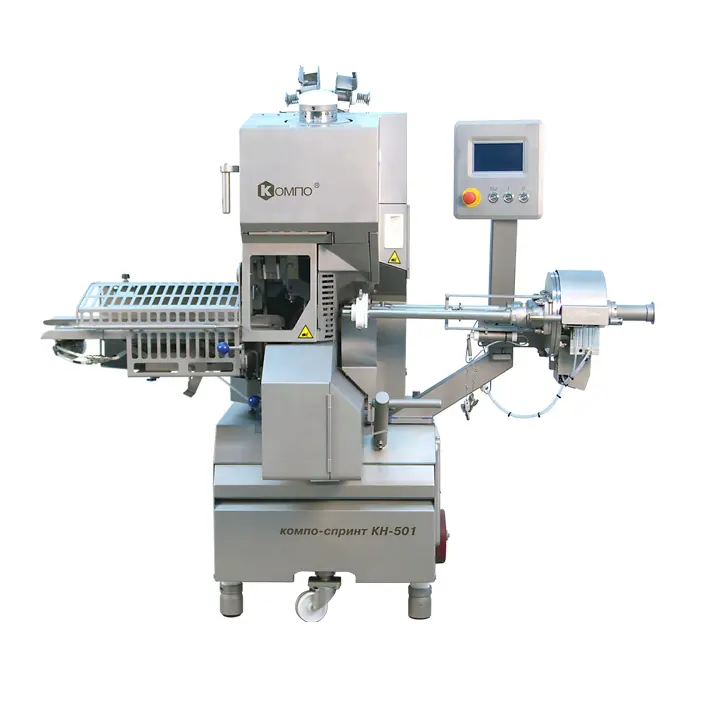Inside a Sausage Clipping Machine Factory – Advanced Clipper Manufacturing for North America

If we say that in today's industrial food processing world, sausage clipping machines are no longer just tools—they are a critical part of high-speed sausage production lines in Canada and the US. But do you know what goes into creating these machines from scratch and how they work?
Take a look at modern sausage clipping machine manufacturing and learn how commercial and pneumatic systems are designed with performance, accuracy, and hygiene requirements in mind.
It's all in text, but even that will give you some insight into the processes.
Where innovation meets engineering
Every commercial batter mixer or industrial clipping machine starts on a designer's screen, or more precisely, first in his imagination and then on the screen.
In today's world, many companies have been manufacturing equipment for years and working with dealers and sales teams to incorporate customer requests and solve problems into new clipper models. Whether it's integration with a vacuum stuffer or ensuring compatibility with different casing materials, every technical detail is taken into account.
CAD software is used to model everything from pneumatic drives to the feed of clamping coils. During the design phase, strength tests are carried out and hygiene protocols and safety mechanisms are developed.
For example, fully automatic double clamping machines such as the KOMPO Sprint KN-501 can process thousands of sausages per hour, but this is only possible thanks to what happens in the factory.
Materials and precision manufacturing
After many hours of design, refinement, and approval, the production of clip sealers begins. Only food-grade stainless steel is used, which is a mandatory requirement for any equipment that will be operated in USDA or CFIA-compliant facilities.
Incidentally, all of our equipment is made of stainless steel, so it is very easy to get our products certified by regulatory agencies.
CNC machines cut, shape, and machine each component with micrometer precision. This is where the real magic happens—ensuring that every trimming machine performs flawlessly, regardless of the intensity of the production cycle, with commercial loops and sausage clips.
At KOMPO North America Inc., all equipment - from semi-automatic clipping machines to pneumatic high-speed models - is assembled in accordance with strict quality control protocols to meet the standards of meat processing plants in Canada and the United States.
Assembly and integration testing
This is where the magic happens, transforming individual parts and mechanisms into a single working machine. The assembly lines are clean, efficient, and often modular. Technicians assemble everything together: the clamping head, the body break, the loop applicator, and the pneumatic systems. Then testing is carried out - not just to check that everything works, but to ensure that everything works perfectly. Our adjusters can spend several days testing and fine-tuning to achieve the best result.
It is important that the machine can handle different types of sausage casings – natural, collagen and plastic – as well as loops and clips from different suppliers. Everything has to be coordinated: tension, pressure, synchronization, blade accuracy.
More than just a machine: support and consumables
No clipper can do without the right consumables. That's why KOMPO North America Inc. also supplies high-quality sausage clips and loops that are fully compatible with P and T brands (you know the ones) and other brands.
And the best part? They are stored in our warehouse in Canada, so customers avoid delays, customs fees, and unexpected prices.
Key features of modern sausage clipping machines
- Pneumatic or fully automatic operation for high-speed production is standard on all modern machines.
- Compatibility with natural, collagen and plastic casings is also essential, as you may have different types of sausages in your product range.
- Adjustable settings for different calibres and loop positions are convenient, with one clipper for all calibres.
- Stainless steel construction for durability and hygiene - one clipper for 10 years and $400 in maintenance during that time is our case.
- Integration with vacuum stuffers and conveyors - well, that's the bare minimum
Advantages for meat producers in North America
- Designed specifically for large-scale sausage production (we have entire chains of equipment for automating the sausage production process)
- Faster setup and less downtime
- Consistent availability of consumables from a Canadian supplier
- Lower total cost of ownership thanks to local service and support
- Seamless operation with standard loops and clips from any manufacturer
